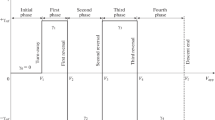Abstract
Results concerning the terminal guidance algorithm at the reentry of the descent module into the Earth atmosphere are presented. This algorithm simultaneously eliminates predicted errors in the longitudinal and lateral directions. The restriction on the load factor n ≤ 3 is taken into account. The motion of the descent module is considered in the disturbed Earth atmosphere using two of global atmosphere models—the TsNIIMash model created in due time for the Energy-Buran project and the Computational Model of the Earth Disturbed Atmosphere (CMEDA) developed in the Keldysh Institute of Applied Mathematics. It is demonstrated that the proposed algorithm guarantees the downrange maneuver zone of 1500 km with a guidance error less than 1 km using three reversals of the bank angle when the descent module enters the atmosphere at an angle of −1.5°. The algorithm automatically adjusts the parameters of the bank angle control function depending on the distance to the desired target in the maneuver zone. For small ranges to the target, the constant load factor mode is realized. For large ranges to the target, sufficient store of energy is reserved for eliminating singular controls. For medium ranges to the target, the so-called k γ mode is used to balance the load factor maximums on the first and the second halves of the descent trajectory.
Similar content being viewed by others
References
Yu. G. Sikharulidze and A. N. Korchagin, “Computational Model of the Earth Disturbed Atmosphere: Advanced Version and Test Results of Ballistic Reentry Trajectories,” in Proc. of the 17th Int. Symp. on Space Flight Dynamics, Moscow, 2003, Vol. 1.
A. N. Korchagin, P. M. Kostochko, and Yu. G. Sikharulidze, “Computational Model of Earth’s Disturbed Atmosphere,” Kosm. Issl. 37, 251–258 (1999).
D. E. Okhotsimskii, Yu. F. Golubev, and Yu. G. Sikharulidze, Algorithms for Spacecraft Control at Atmosphere Reentry (Nauka, Moscow, 1975) [in Russian].
A. G. Glazkov, K. Z. Ibragimov, A. V. Klimenko, et al., “Controling Spacecraft at Atmosphere Reentry,” Kosm. Issl. 7(2), 163–170 (1969).
E. L. Akim, A. P. Astakhov, R. V. Bat’ko, et al., “Autonomous Navigation System of Near-Earth Spacecraft,” J. Comput. Syst. Sci. Int. 48, 295–312 (2009).
Yu. G. Sikharulidze, Ballistics and Guidance of Vehicles (BINOM, Moscow, 2011) [in Russian].
COSPAR International Reference Atmosphere 1986 (CIRA 1986).
Yu. N. Kaluzhskikh and Yu. G. Sikharulidze, “A Control Algorithm for Reentry of a Rescue Space Vehicle into the Earth’s Atmosphere,” Kosm. Issl. 38, 2622–269 (2000).
V. P. Kirpishchikov, “Descent and Landing Trajectories of the Orbiter Buran,” in Automatic Control Algorithms: Aviation and Space Systems (Izd. MAI, Moscow, 1997), pp. 46–55 [in Russian].
Author information
Authors and Affiliations
Corresponding author
Additional information
Original Russian Text © S.N. Evdokimov, S.I. Klimanov, A.N. Korchagin, E.A. Mikrin, Yu.G. Sikharulidze, 2012, published in Izvestiya Akademii Nauk. Teoriya i Sistemy Upravleniya, 2012, No. 5, pp. 102–118.
Rights and permissions
About this article
Cite this article
Evdokimov, S.N., Klimanov, S.I., Korchagin, A.N. et al. Terminal control algorithm for the downrange motion of a descent module with load factor constraints. J. Comput. Syst. Sci. Int. 51, 715–731 (2012). https://doi.org/10.1134/S1064230712040041
Received:
Accepted:
Published:
Issue Date:
DOI: https://doi.org/10.1134/S1064230712040041




